Deep Learning for Engineers
- Добавил: literator
- Дата: 4-01-2024, 09:45
- Комментариев: 0
 Название: Deep Learning for Engineers
Название: Deep Learning for EngineersАвтор: Tariq M. Arif, Md Adilur Rahim
Издательство: CRC Press
Год: 2024
Страниц: 170
Язык: английский
Формат: pdf (true)
Размер: 18.9 MB
Deep Learning for Engineers introduces the fundamental principles of Deep Learning along with an explanation of the basic elements required for understanding and applying Deep Learning models.
As a comprehensive guideline for applying Deep Learning models in practical settings, this book features an easy-to-understand coding structure using Python and PyTorch with an in-depth explanation of four typical deep learning case studies on image classification, object detection, semantic segmentation, and image captioning. The fundamentals of convolutional neural network (CNN) and recurrent neural network (RNN) architectures and their practical implementations in science and engineering are also discussed.
Deep Learning is a rapidly growing branch of machine learning that uses many hidden layers to extract features from a large dataset. It is an advanced form of neural network algorithm, where the term “neural” is used to emphasize a learning process comparable to our human brains. Recently, deep learning has seen tremendous growth and achieved significant milestones. This growth and successful implementation of Deep Learning applications can be attributed to the rise of Graphical Processing Unit (GPU) hardware, readily accessible large data sets, and open-source Machine Learning frameworks. Also, many cloud service providers, such as Amazon Web Service (AWS), Google Cloud Platform, and Microsoft Azure, offer GPU-enabled computing and pay-per-use models, which makes it convenient to develop sophisticated deep learning models. Besides GPU hardware, recently, Tensor Processing Units (TPUs) are also used in many cases for effective and faster deep learning computations. Deep learning-based design has already been used in a wide variety of engineering domains, such as autonomous cars, intelligent robotics, computer vision, Natural Language Processing (NLP), and bioinformatics. Additionally, numerous real-world engineering applications can efficiently utilize an existing pre-trained Deep Learning model that has already been developed and optimized for a related task.
In the last several years, there has also been a surge in academic research on Deep Learning in almost every domain of science and engineering. Many engineering and manufacturing companies are also competing and investing heavily in Deep Learning or Artificial Intelligence-based research.
Some basic knowledge of Python programming is required to follow this book. However, no chapter is devoted to teaching Python programming. Instead, we demonstrated relevant Python commands followed by brief descriptions throughout this book. A common roadblock to exploring the deep learning field by engineering students, researchers, or non-data science professionals is the variation of probabilistic theories and the notations used in data science or computer science books. In order to avoid this complexity, in this book, we mainly focus on the practical implementation part of deep learning theory using Python programming. We assume this approach will make this book interesting and easy to follow. Also, it will give a practical understanding to the reader without going through mathematical details. Another major challenge in exploring deep learning is the GPU configuration and dependency installation tricks in the Pytorch, which require a significant amount of time and effort for newcomers. This unique area is also covered in detail in this book.
This book includes exercise problems for all case studies focusing on various fine-tuning approaches in Deep Learning. Science and engineering students at both undergraduate and graduate levels, academic researchers, and industry professionals will find the contents useful.
Скачать Deep Learning for Engineers
Внимание
Уважаемый посетитель, Вы зашли на сайт как незарегистрированный пользователь.
Мы рекомендуем Вам зарегистрироваться либо войти на сайт под своим именем.
Уважаемый посетитель, Вы зашли на сайт как незарегистрированный пользователь.
Мы рекомендуем Вам зарегистрироваться либо войти на сайт под своим именем.
Информация
Посетители, находящиеся в группе Гости, не могут оставлять комментарии к данной публикации.
Посетители, находящиеся в группе Гости, не могут оставлять комментарии к данной публикации.
